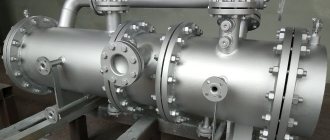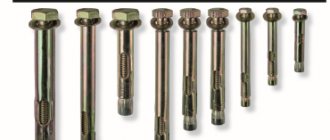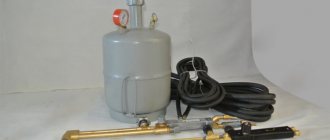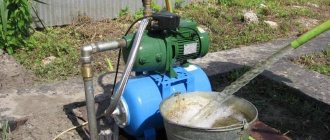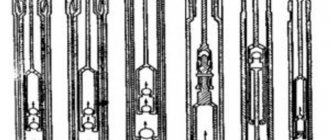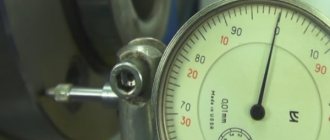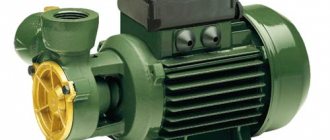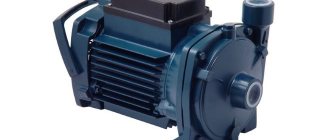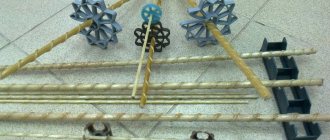Vertical models of centrifugal pumps have become widespread in everyday life and in industrial settings. Their distinctive feature is a vertically located shaft, due to which small platforms are required to accommodate the equipment. A vertical centrifugal pump can be used not only as an independent unit, but also as one of the components of an overall water supply or wastewater system.
Design and operational features
A characteristic feature of vertical pumps is a vertically located working shaft, due to which such equipment got its name. This arrangement is quite complex to implement, but it allows the pump to perform highly specialized tasks, in which it is significantly superior to its horizontal counterparts.
There are many types of pumps - drainage, slurry, water, cantilever, and can be made in both vertical and horizontal configurations. The use of vertical units is rational in case of limited working space, since their cylindrical body takes up minimal space. Their compactness makes vertical pumps widely used in shipbuilding and mechanical engineering, since they can easily fit inside the housings of large structures.
The second main area of operation of such equipment is pumping liquid from reservoirs and reservoirs. Thus, almost all water pumps - submersible, semi-submersible and drainage, are made in a vertical configuration. Semi-submersible pumps in a cylindrical casing often have the highest possible tightness class, since their drive can be located above the surface of the water, and the working element below its level.
Pipe mounted pump
The advantage of vertical type units is the ability to insert into pipelines. An example of such rationalization is a heat circulation pump, which is installed directly into an existing pipeline using flanges, without the need for additional connections and pipes.
However, the vertical arrangement of the working shaft also has a number of disadvantages, the main one of which is the complexity of the design in order to compensate for increased axial loads. For this, more powerful angular contact bearings are used, which, in turn, require changes to the standard lubrication system. In general, the overall efficiency of vertical units fully compensates for the above disadvantages.
Scope of application and classification
Vertical pumps are widely used in sewer and water supply systems for pumping liquids of any contaminant. The main areas of operation of such equipment are:
- drainage systems;
- heating and water supply;
- mechanical engineering, machine tool building;
- irrigation, reclamation and filtration systems;
- sewerage and treatment complexes;
- chemical industry.
The classification of vertical type units is carried out according to many factors, let’s consider the main ones:
- Fluid supply power - low-pressure, medium- and high-pressure.
- The speed of the working shaft is quiet, normal and high-speed.
- Number of pumped flows - single-stage, multi-stage.
- Type of working environment - for water, contaminated liquids, aggressive chemical substances, sewage waste.
- Installation method: ground, submersible and semi-submersible.
- Drive type: centrifugal, piston, screw.
Inline pump
The most common centrifugal-type units are in most cases represented by “inline” circulation equipment. Vertical pumps are installed directly into the pipeline through a flange connection. Semi-submersible units for tanks and tanks are also produced with such drives.
The centrifugal working mechanism consists of a blade wheel mounted on a working shaft. Such a wheel consists of two parallel disks connected by plate bridges. During operation, the blades are filled with water, which is pushed outward during rotation.
Depending on the number of bladed ears, circulation pumps are single-stage and multi-stage. Multi-stage units are capable of developing a much higher supply pressure, since the water in them sequentially passes through the cells of each of the wheels.
Centrifugal pump device
The operating cycle of piston pumps consists of alternating stages of suction and discharge produced by the movement of the cylinder-piston group. During the translational movement of the piston, a reduced pressure is created in the vacated cavity of the cylinder and water is sucked into it from the supply pipe. Next, the valve on the suction pipe closes, and on the supply pipe it opens, and the cylinder moving backwards pushes water out of the piston.
The key disadvantage of vertical piston pumps is uneven, pulsating flow, and less power than centrifugal units. However, piston equipment costs much less than centrifugal equipment, which is why such water and drainage pumps are widely used in household use.
How does a vertical slurry pump work? (video)
This is interesting: Cantilever pumps: device features, rules for selection and maintenance
How are centrifugal pumps classified?
Centrifugal vertical pumps and all centrifugal products are classified according to:
- The number of wheels they come in is:
- single-stage with one wheel, which can be cantilever;
- multi-stage, with a large number of wheels.
- Pressure is distinguished:
- with low pressure up to 2 kgf/cm2;
- with an average pressure from 2 to 6 kgf/cm2;
- with high pressure, which is more than 6 kgf/cm2.
- Method of supplying water to the impeller. The water supply to the impeller can be:
- with one-way liquid inlet;
- double suction, when water is supplied from both sides.
- Shaft location. Centrifugal pumps are:
- horizontal;
- vertical.
- Housing connector. The housing connector is:
- horizontal;
- vertical.
- The method of draining liquid from the impeller into the spiral channel of the pump housing:
- spiral centrifugal pumps, in which the liquid is discharged directly into a spiral channel;
- turbine Here, before entering the spiral channel, the liquid must pass through a special device, which is a guide apparatus consisting of a stationary wheel with blades.
- Impeller rotation speed levels:
- slow-moving;
- with normal rotation speed;
- high-speed devices.
- Type of liquid pumped by the pump:
- plumbing;
- sewer;
- alkaline and acidic;
- dredgers;
- oil and others.
- Method of connection to the motor:
- driven, with a pulley or gearbox;
- connection via a coupling.
The kit with centrifugal pumps should include:
- A receiving check valve with a mesh, which is necessary to retain water in the pump suction pipe and housing when filling it before starting, and the mesh should retain large suspensions floating in the water.
- Valve.
- A vacuum gauge used to measure the vacuum on the suction side. The device is placed on a water pipe between the valve and:
- device body;
- a tap through which air is released during filling is placed in the upper part of the body;
- on the pressure pipeline with a check valve that prevents water from entering through the pump when another pump is operating in parallel, in the opposite direction.
- A valve on the pressure pipeline, which is necessary for starting, stopping and adjusting the pressure and productivity of a centrifugal pump.
- A pressure gauge for measuring the pressure on the pressure pipe, which is developed by the pump.
- The safety valve, located behind the valve on the pressure valve, serves to protect the pressure pipe, pipeline and the pump itself from water hammer.
- Device for filling the pump with water.
Tip: When purchasing a centrifugal pump, you need to make sure that all components are available, according to the attached operating instructions, and check the serviceability of the device.
Classification
Vertical multistage centrifugal pumps are divided into different subgroups, depending on the following factors:
- method of connecting to an electric drive (gear, direct drive, pulley);
- the number of stages (shafts with blades) located on one impeller;
- speed of operation (low-speed, normal, high-speed);
- location in relation to the pumped material (surface, semi-submersible, submersible);
- one or two inlets through which liquid is absorbed;
- the type of liquid that is pumped by the pump (water, drainage, chemical, fecal, etc.);
- productivity - different pumps pump different volumes of material per unit of time;
- pressure - determines the height to which the pump can lift the liquid medium. The most powerful ones can deliver water to a height of up to 330 meters.
A little history
The simplest pumps have been known since before our era. But the idea of using centrifugal force in the process of pumping water appeared to Leonardo da Vinci at the turn of the 15th-16th centuries, but only in sketches. It is not known for certain when exactly a full-fledged centrifugal pump was developed, so no one can name a single inventor.
At the beginning of the 17th century, the Frenchman Blancano built the simplest possible installation that could supply water using a rotating impeller. A centrifugal pump with a four-blade impeller located in a volute casing was first proposed by the Frenchman Denis Papin at the end of the 17th century. The first vertical centrifugal pump design was tested and introduced by engineer Le Demur in the first half of the 18th century, and the classic wheel shape appeared only at the beginning of the 19th century. Centrifugal pumps became widely used after they began to be equipped with an electric motor.
Russian and foreign inventors have been working independently on the creation of full-fledged units for decades.
The design of a vertical pump with several stages appeared at the turn of the 19th-20th century thanks to our compatriot, the Russian engineer Pushechnikov. His pumping unit could pump water from wells up to 250 meters deep.
Correct operation is the key to long service life
Failure-free operation of centrifugal pumps can be ensured by organizing the required operating conditions for the equipment and installing monitoring devices. A valve and an appropriate filter will help protect the impellers from foreign bodies. A check valve with a pressure gauge that determines the pressure at the inlet pipe will help avoid the occurrence of cavitation processes.
A pressure gauge that records the pressure inside the pump will help prevent water hammer.
When choosing vertical centrifugal units, you should focus on their characteristics. The most important parameters are:
- power consumption;
- performance;
- water jet pressure at the outlet;
- external dimensions;
- material for the manufacture of the flow part and working parts that come into contact with the pumped liquid.
The lifespan of pumping equipment largely depends on its correct use. Vertical pumps should not be installed in an inclined position, much less in a horizontal position. They are strictly not allowed to be used for pumping media not specified in the instructions. The water pump will not withstand the action of aggressive or viscous liquid; it must not be installed in drainage systems where solid particles may be present. But it makes no sense to purchase expensive chemical pumps for watering your garden.
If pumping equipment is used in winter, it will need to be insulated or installed in a heated room. Otherwise, the housing may depressurize and even burst.
Compliance with operating rules will help prolong the full operation of any centrifugal pumps, including vertical ones.
This is interesting: Centrifugal pumps: design, principle of operation, advantages and disadvantages
Purpose and scope of application of vertical pumps
Given their popularity, it is important to know in what cases and for what purpose centrifugal pumps should be used. A vertical centrifugal pump can be used not only as a stand-alone pump, but also as part of a large interconnected water supply or wastewater system.
This kind of pumping devices are usually used in water supply and sewerage systems for pumping both clean, clogged, and even aggressive media with a low degree of viscosity. Users always note their compactness, ease of maintenance, high efficiency and, best of all, they have lower noise levels than other submersible stations.
Taking into account all of the above advantages, a single-stage centrifugal pump, and, if necessary, a multi-stage pump, is widely used for various purposes, the main of which are:
- supply or drainage of water;
- heating of premises;
- drainage;
- filtration or reclamation;
- cleaning and much more.
Vertical pump on an industrial pipeline
But still, most often they are used as water pumps.
In the USA, at most chemical plants under construction, centrifugal single-stage high-speed pumps are installed, which are produced by the well-known company Sundstrand Corporation, founded in 1926.
Vertical pumps easily combine two important criteria: ease of maintenance and installation costs. It is important to note the fact that these units work perfectly with high and low pressure supplies and flawlessly guarantee more than 46 thousand hours of continuous and error-free service.
Classification of vertical pumps
Centrifugal pumps can be sorted according to many criteria. For example, if we take into account the pressure, then they come with a low, medium or high level. If we take into account the degree of pressure, it can be low (up to 0.2 MPa), medium (from 0.2 to 0.6 MPa) or high (more than 0.6 MPa). Depending on the location of the wheel axle in space, there are horizontal and vertical ones.
Also a distinctive feature is the connection option with an electric motor, namely with a direct drive, gear mount or with a pulley. The method of draining liquid from the impeller into the housing channel in the diaphragm can be spiral or bladed. But most often they are distinguished by the method of immersion: land-based, semi-submersible or submersible.
Today, the vertical slurry pump is incredibly popular. This pump has a wide range of design features, since a cantilever shaft with a bearing housing and a drive, which is located on the top of the tank, rotates the impeller from inside the diaphragm housing itself. All pump sizes can be configured with a range of column lengths and impeller designs. Ideal for aggressive and coarse particles of high concentrations of cellulose slag and widely used in the metallurgical, mining and coal industries.
According to Klint Bawden, development manager at Swedish pump manufacturer ITT Water & Wastewater, the market trend is moving away from vertical spindle diaphragms towards submersible slurry pumps. “This is because these pumps are more convenient, require less infrastructure, are quieter in operation and are more efficient than vertical spindle diaphragms.”
Vertical centrifugal pump Wilo HELIX VE 1012-2/25/V/KS
He points out that because submersible pumps operate directly in slurry, they require no support structure and take up less space. In addition, the motor and body volutes are an integrated unit, making it compact and easy to install. Another important advantage is that, when working underwater, the noise level is automatically reduced and, in some cases, silent operation is guaranteed.
As Klint says: “Add to this the Victaulic flange and coupling of the Flygt 5100/5150 series pumps for quick and easy connection to all models of commonly available fittings and you have a versatile VSP.”
Operating principle of a centrifugal vertical pump
Centrifugal pump design diagram
According to the diagram, the vertical centrifugal pump includes:
- 1 – impeller.
- 2 – blades.
- 3 – spiral type housing.
The fluid enters the impeller in the axial direction. The centrifugal force that arises when the impeller rotates presses the liquid against the housing wall, which is then pushed tangentially to the impeller into the discharge hole. At the same time, the pressure at the inlet to the pump drops, and the liquid, which is under high pressure, rushes into the impeller. For example, pumping liquid from an open tank occurs under the influence of atmospheric pressure. Centrifugal pumps have a number of advantages over other types of pumps, which makes them more popular:
- Liquid supply occurs continuously.
- Simplicity of the device.
- Relatively low price.
- Greater reliability.
- Quite high efficiency: from 0.6 to 0.8.
- Increased suction lift.
- Automation of control can be done easily.
Tip: Using an automatic control system for a centrifugal pump will make it easier to work with the device and increase its service life by timely shutdown in case of malfunctions.
The disadvantages of vertical centrifugal pumps include:
- Depending on the resistance of the network where they operate, the liquid supply can vary within wide limits.
- The inconvenience is that in the usual version, when starting a centrifugal pump, it must be filled with water if the level of the pumped liquid is below the inlet pipe.
Parameters and varieties
Pumps with a vertical shaft and impeller arrangement, belonging to centrifugal type devices, are classified according to the following characteristics:
- pressure (depending on the value of this parameter, vertical pumps can be with low, medium or high pressure levels);
- operating speed (based on this characteristic, normal, low-speed or high-speed hydraulic machines are distinguished);
- volume of working medium pumped per unit of time (device performance);
- the number of steps, which can be sections or rings of equipment;
- the number of lines through which the pumped medium enters the device (one- or two-way devices);
- the type of liquid medium for which the pump is intended to pump (drainage, fecal, chemical, water, etc. electric pumps);
- the location of the device relative to the medium it pumps (ground models, submersible and vertical semi-submersible pumps);
- method of connection with the drive electric motor (direct drive, gear and pulley hydraulic machines).
Vertical centrifugal pumps with normal suction for baseplate mounting
Vertical pumps are successfully used for pumping clean, contaminated and chemically aggressive liquid media characterized by a low degree of viscosity. The most significant advantages of hydraulic machines of this type include:
- compactness;
- ease of use and maintenance;
- high efficiency;
- low level of noise generated during operation.
Due to the above advantages, vertical multistage centrifugal pumps (as well as single-stage ones) are actively used to equip the following systems:
- autonomous water supply;
- heating;
- drainage and purification of liquid media;
- condensation;
- filtration, irrigation and reclamation.
Vertical pumps at a water intake station
A vertical centrifugal pump, which raises the fluid it pumps to a higher level by increasing the pressure of its flow, can fall into one of the following categories:
- hydraulic machine of surface or ground type;
- semi-submersible pump;
- submersible type device.
Both surface models and semi-submersible and submersible pumps are equipped with an electric motor, which ensures the rotation of the impellers of such devices.
Surface pumps of the vertical type, as their name implies, are installed on the surface of the earth, in close proximity to the reservoir from which the liquid must be pumped out. The place for installing such equipment can be a pit or a specially prepared area that does not come into contact with the surface of the pumped liquid medium. A semi-submersible vertical pump, as also follows from its name, is only partially lowered into the pumped liquid medium, while the drive motor remains above the surface of the liquid.
Semi-submersible vertical chemical pump
During operation, the housing of submersible pumps is completely located in the thickness of the pumped liquid medium. If a vertical semi-submersible pump cannot be installed in wells whose shafts are characterized by a curved shape, then a submersible type device has this capability.
It should be borne in mind that vertical type electric pumps cannot be started until the inside of their housing is filled with liquid. If this requirement is neglected, the pump will run at idle speed, which can lead to overheating and, accordingly, premature failure.
Multistage centrifugal pumps of the vertical type are distinguished by higher power, which are able to significantly increase the pressure of the flow of the pumped liquid medium, which cannot be said about single-stage models. At the same time, the power and efficiency of multistage vertical type pumps are higher, the more sections there are in the design of such devices. Each of the sections connected to each other in series contributes to an increase in the kinetic energy of the flow of the pumped liquid medium.
Multistage vertical pumps
In multistage centrifugal vertical pumps, the pumped liquid sequentially passes through all sections of the device before entering the pressure pipe, which makes it possible to significantly increase the pressure of the working medium at the outlet. Depending on the model, pumps of this type may contain in their design a different number of impellers (from 2 to 10), which are fixed on one shaft, but are located in separate modules each.
Vertical multistage pump design
The modules of a multistage vertical pump are placed in one casing, which is installed between the suction and pressure chambers of the device. All elements of the body of a multistage electric pump, the nozzles of which are located in the same horizontal plane, are tightened with pins, and the joints between them are sealed using sealing elements.
As mentioned above, multistage centrifugal pumps, due to their design features, can significantly increase the pressure of the pumped liquid medium at the outlet. The pressure of the fluid flow created by a multistage pump is the sum of the pressure values generated by each of its stages.
Vertical shaft units
Two brands of single-stage devices for clean water are produced: 20 HB and 28 HB. They are designed for installation in buried stations. In this installation, the heel of the electric motor absorbs axial forces. The pump seal is equipped with a hydraulic seal with soft padding. Type NV units are directly connected to electric motors or by means of solid seam couplings via an intermediate shaft. The single-stage vertical centrifugal pump has a capacity from 3240 to 10,800 cubic meters per hour and a head from 29 to 40 meters.
The principle of connecting components
With the help of relief holes, the axial pressure is partially balanced. The wheel is also equipped with an axial seal on the rear side. A tube with a branch pipe is connected to the pressure relief chamber of the pump. A second ball bearing is installed to fix the rotor and better absorb the unbalanced axial force. The pump seals are equipped with a hydraulic seal.
Such installations have a capacity of 28 to 100 liters per second with a head of 12 to 98 meters. High-performance single-stage pumps mostly have a two-way supply option. At normal axial pressure, a good double-flow impeller has fairly high cavitation rates.
Pumps of the NF, NFuV and FV brands. Open and diagonal devices
The following standard sizes of installations are provided: 2NF, 4NF, 6NF, 8NF. Their productivity ranges from 36 to 864 cubic liters per hour with a pressure of 6.5 to 50 meters. Similarly to such installations, sewage pumps with an open impeller with two thick blades can be used. In such devices, all fibers are cut by the sharp edge of the blade.
To work with wastewater, a single-stage diagonal-type centrifugal pump is often used. The impeller in these units, as well as in models of the FV and NFuV brands, is equipped with two blades. Their productivity varies from 43 to 150 cubic meters per hour, and the pressure reaches 63 m.
Centrifugal single-stage pump and its properties
The operational properties of such pumps are determined by their main parameters: power, pressure, cavitation reserve, flow, suction height. Important operating qualities of the units are the electric motor voltage and wheel speed.
It must be understood that the parameters of axial and centrifugal pumps are variable even with continuous action of the impeller and will depend on the flow. It is customary to show characteristics for reduced wheel diameters in the drawings. The characteristics of optimal operating points correspond to maximum efficiency. Adequate recruitment and flow are acceptable pump performance. These characteristics are included in the designation of installations.
Dredgers
Dredgers are used to pump mixtures of loosened soil and liquid through pipes to the required distance. Today, the market produces pumps with a transportation range of up to 5 km and a capacity of 40 to 1200 cubic meters per hour. With the help of dredgers, it is possible to develop excavations up to 15 m deep below the water horizon. These installations have a number of features due to the high concentration of large particles in the pumped water mass. For this reason, a wear-resistant wheel is created from manganese hard steel.
The single-stage vertical centrifugal pump is protected by armor on the inside of the housing to prevent rapid wear. To prevent the mechanism from becoming unusable so quickly, purified water is supplied between the wheel into the left cavity and to the oil seal through special drillings to flush out solid fragments from these places.
Radial blades are installed on the outer part of the working and covering wheel disks. They are selected so that the axial amplifier comes into balance during rotation.
Features of sewage pumps
The single-stage centrifugal pump is used for pumping sewage liquid, wastewater and sludge. One of the main reasons why pumps stop during use is their clogging. To prevent debris from getting into the mechanisms, special grilles are provided. Their installation necessitates changing the installation form.
Such pumps are sealed with steel rings with a sharp edge that cuts the fibers that get into the seals. The units are equipped with covers that provide easy access for cleaning the suction part of the impeller. The number of blades is kept to a minimum to reduce the possibility of clogging. The passages between them thus increase. Quite often the number of blades is reduced to two.
The cantilever single-stage centrifugal sewage pump is created from materials that are not susceptible to corrosion. Its body contains several connectors necessary for partial disassembly during the cleaning process. The inlet edges of the blades are very rounded. Thanks to this, fibrous bodies will not get stuck on them.
